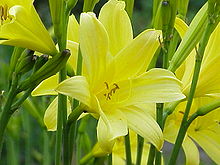| Hemerocallidoideae | |
|---|---|

| |
| Hemerocallis | |
| Scientific classification | |
| Kingdom: | Plantae |
| Clade: | Tracheophytes |
| Clade: | Angiosperms |
| Clade: | Monocots |
| Order: | Asparagales |
| Family: | Asphodelaceae |
| Subfamily: | Hemerocallidoideae Lindley |
| Genera | |
|
See text | |
Hemerocallidoideae is a subfamily of flowering plants, part of the family Asphodelaceae sensu lato in the monocot order Asparagales according to the APG system of 2016.[1] Earlier classification systems treated the group as a separate family, the Hemerocallidaceae. The name is derived from the generic name of the type genus, Hemerocallis. The largest genera in the group are Dianella (with 20 species), Hemerocallis (15), and Caesia (11).
In the 21st century, the group has had two basic forms, depending on whether Johnsonia and its relatives are included or not. Each of these forms can vary by the inclusion or exclusion of Xeronema. If defined narrowly, most of the group are native to tropical and temperate Eurasia and Australia. They also occur in New Zealand, many Pacific islands, western South America, and Madagascar, but not in Sub-Saharan Africa or North America.[2] If defined broadly, then the group includes the genus Caesia, which is indigenous to Southern Africa, as well as Australia.[3]
The APG III system of 2009 used the broader definition of the group,[4] treating it as the subfamily Hemerocallidoideae of the family Xanthorrhoeaceae sensu lato.[5] In the APG IV system of 2016 the name Asphodelaceae is used in preference to Xanthorrhoeaceae.[1]
Hemerocallis fulva is a common ornamental. Other species of Hemerocallis are cultivated as well. Hemerocallis citrina has medicinal uses. Phormium tenax is a traditional source of fiber in New Zealand.[citation needed]




- ^ a b Angiosperm Phylogeny Group (2016). "An update of the Angiosperm Phylogeny Group classification for the orders and families of flowering plants: APG IV". Botanical Journal of the Linnean Society. 181 (1): 1–20. doi:10.1111/boj.12385.
- ^ Ole Seberg. 2007. "Hemerocallidaceae" pages 370-371. In: Vernon H. Heywood, Richard K. Brummitt, Ole Seberg, and Alastair Culham. Flowering Plant Families of the World. Firefly Books: Ontario, Canada. ISBN 978-1-55407-206-4.
- ^ Ole Seberg. 2007. "Johnsoniaceae" page 376. In: Vernon H. Heywood, Richard K. Brummitt, Ole Seberg, and Alastair Culham. Flowering Plant Families of the World. Firefly Books: Ontario, Canada. ISBN 978-1-55407-206-4.
- ^ Angiosperm Phylogeny Group (2009), "An update of the Angiosperm Phylogeny Group classification for the orders and families of flowering plants: APG III", Botanical Journal of the Linnean Society, 161 (2): 105–121, doi:10.1111/j.1095-8339.2009.00996.x, hdl:10654/18083
- ^ Chase, Mark W.; Reveal, James L.; Fay, Michael F. (2009). "A subfamilial classification for the expanded asparagalean families Amaryllidaceae, Asparagaceae and Xanthorrhoeaceae". Botanical Journal of the Linnean Society. 161 (2): 132–136. doi:10.1111/j.1095-8339.2009.00999.x. ISSN 0024-4074.